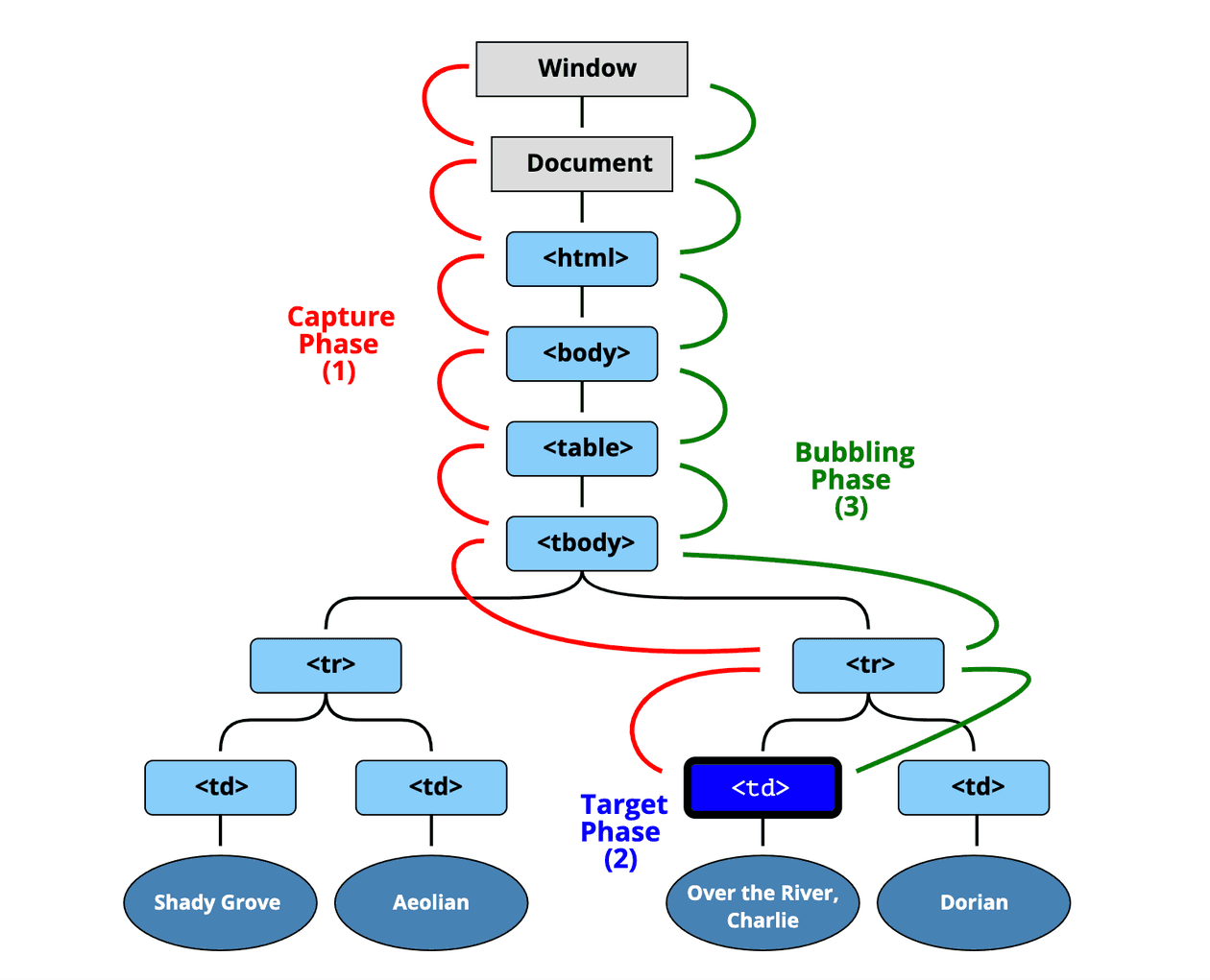Event Bubbling
Event bubbling occurs when an event is triggered on an element, and instead of stopping there, the event propagates up to the parent elements, triggering their event handlers as well. This means that the event "bubbles up" through the DOM tree. The bubbling process continues until it reaches the topmost parent element.
Does Event Bubbling Occur for All Events?
Whether an event bubbles up depends on its bubbles property. Not all events exhibit bubbling behavior, but most events do, except for certain ones like focus events.
<style>
body * {
margin: 10px;
border: 1px solid blue;
}
</style>
<form onclick="alert('form')">
FORM
<div onclick="alert('div')">
DIV
<button onclick="alert('button')">BUTTON</button>
</div>
</form>
1. The onclick handler assigned to the button tag is executed.
2. The onclick handler assigned to the div tag is executed.
3. The onclick handler assigned to the form tag is executed.
4. The event continues to bubble up until it reaches the document object.
event.target vs. event.currentTarget
- event.target refers to the exact element where the event occurred, providing information about where the event was triggered.
- event.currentTarget (or this) refers to the element to which the event handler is attached, regardless of where the event actually occurred.
Why Does event.currentTarget Become null in Asynchronous Console Logs?
import './styles.css';
const form = document.querySelector('form');
form.onclick = handleClick;
function handleClick(event) {
event.preventDefault();
console.log(event.currentTarget); // <form ...>... </form>
setTimeout(() => {
console.log('settimeout:', event.currentTarget); // null
alert('target = ' + event.target.tagName + ', this=' + this.tagName);
}, 0);
}
currentTarget is only accessible while the event is being handled. In an asynchronous call, the event has already completed, causing event.currentTarget to be lost.
When Is event.currentTarget Useful?
A common use case is handling modal overlays. For example, when clicking outside a modal, we want to close it. However, if the user clicks inside the modal, it should remain open. By checking event.target, we can determine whether the click occurred inside the modal and prevent it from closing in that case.
import React, { useRef, useState, useEffect } from 'react';
import styled from 'styled-components';
import { Modal } from '../Modal';
export const ModalExample: React.FC = () => {
const ref = useRef<HTMLDivElement>(null);
const [isOpen, setIsOpen] = useState(false);
useEffect(() => {
const handleOverlayClick = (e: MouseEvent) => {
if (isOpen && ref.current && !ref.current.contains(e.target as Node)) {
setIsOpen(false);
}
};
document.addEventListener('click', handleOverlayClick);
return () => document.removeEventListener('click', handleOverlayClick);
}, [isOpen]);
return (
<Container>
{isOpen && <ModalOverlay />}
<button onClick={() => setIsOpen(true)}>Open Modal</button>
<Modal ref={ref} isOpen={isOpen} onClose={() => setIsOpen(false)} />
</Container>
);
};
const Container = styled.div`
background-color: white;
width: 100%;
min-height: 100vh;
position: relative;
`;
const ModalOverlay = styled.div`
position: absolute;
background: rgba(0, 0, 0, 0.5);
width: 100%;
height: 100%;
`;
Stopping Event Bubbling
Since bubbling continues up the DOM tree until it reaches the document object, it can be stopped using event.stopPropagation(), which prevents the event from bubbling up further.
Difference Between event.stopPropagation() and event.stopImmediatePropagation()
- stopPropagation() prevents the event from bubbling up to parent elements.
- stopImmediatePropagation() stops the bubbling and prevents other event handlers on the same element from executing.
Example:
<div class="container">
<h1># stopPropagation</h1>
<div class="parent">
<h3>parent</h3>
<div class="child">
<h3>child</h3>
<div class="grand-child">
<h3>grand child</h3>
</div>
</div>
</div>
</div>
function sayBye(event) {
alert(`Bye`);
}
function sayHey(event) {
alert('Hey');
event.stopImmediatePropagation(); // Compare with event.stopPropagation()
}
const grandChild = document.querySelector('.grand-child');
grandChild.addEventListener('click', sayHey);
grandChild.addEventListener('click', sayBye);
With stopImmediatePropagation(), only sayHey will execute, while sayBye will be ignored.
Event Capturing
There are three phases in the standard event flow:
1. Capturing Phase – The event moves down the DOM tree towards the target.
2. Target Phase – The event reaches the target element.
3. Bubbling Phase – The event bubbles up the DOM tree.

By default, event handlers listen during the bubbling phase, meaning they trigger after the event reaches the target.
To listen during the capturing phase, set { capture: true } in addEventListener():
elem.addEventListener("click", handler, { capture: true });
// This is the same as:
elem.addEventListener("click", handler, true);